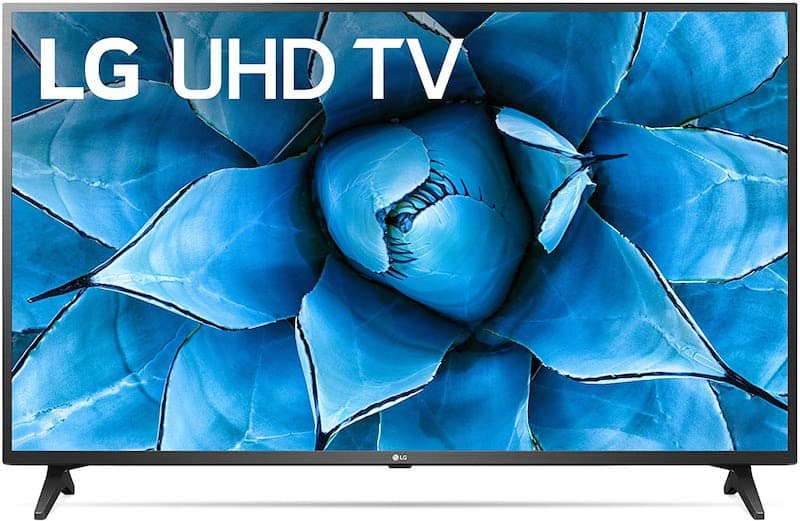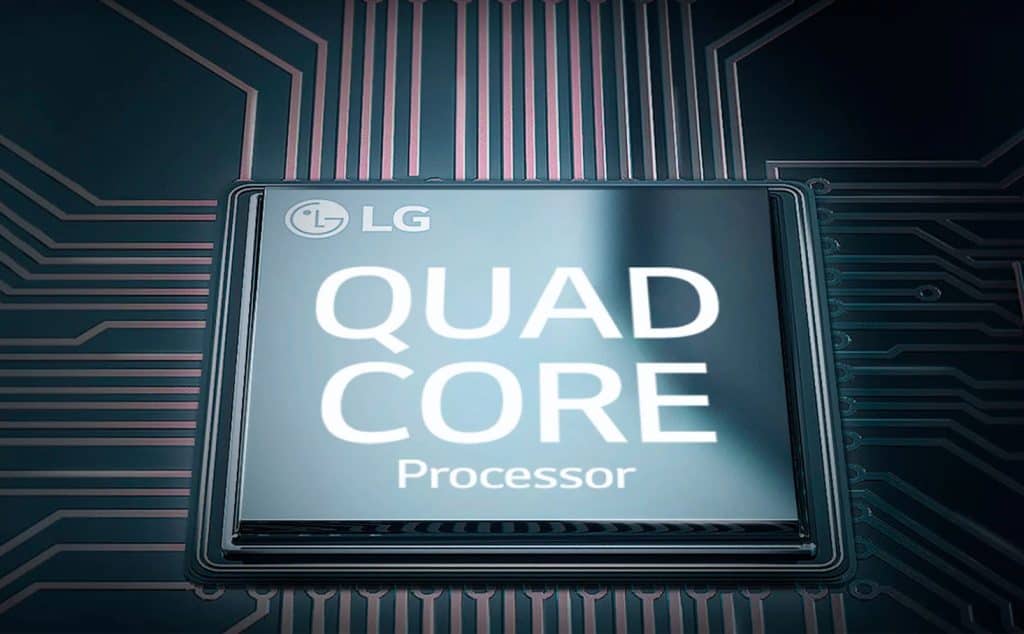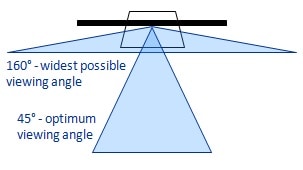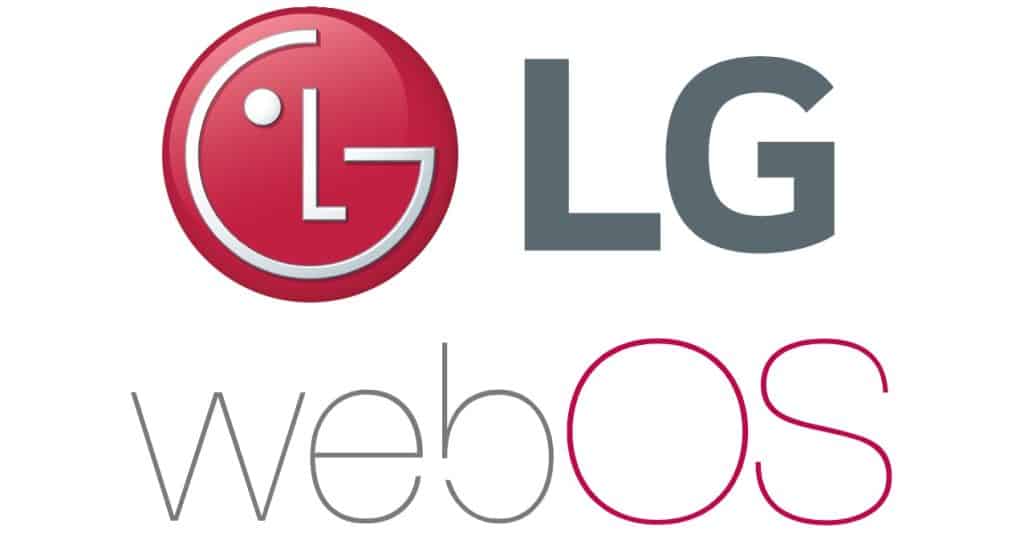It goes without saying that LG is one of the best and most reputable TV manufacturers around. Its premium models from the OLED line deliver excellent picture quality with many next-gen features and are often accompanied by steep price tags.
That said, in this article, we’ll take a closer look at two LG models better-suited for shoppers on a tighter budget. The LG UN7000 and the LG UN7300 offer recognizable LG quality but don’t come with many advanced features, meaning that they are more competitive with budget brand models.
If you’re looking to buy a budget-priced LG TV, this detailed LG UN7000 vs UN7300 comparison post will help you sort through their similarities and differences so that you can choose the more suitable model for your needs and preferences.
LG UN7000 vs UN7300 – Quick Comparison
LG UN7000

If you’re buying on a budget and are looking for a quality entry-level 4K TV, the UN7000 is an outstanding option. It has its limitations but is generally suitable for mixed usage and excels as a TV monitor. That said, here are UN7000’s most significant pros and cons:
Pros:
- Great Smart TV platform
- Very wide viewing angles
- Solid image upscaling power
- Impressively low input lag
Cons:
- No voice control support
- Low SDR peak brightness.
LG UN7300

The UN7300 is an okay budget TV suitable for all-around usage. At its price tag, it provides excellent picture quality with good image upscaling power and superb reflection handling. Let’s take a look at UN7300’s biggest advantages and disadvantages:
Pros:
- Great Smart TV platform
- Excellent connectivity features
- Impressively low input lag
- Very good reflection handling
Cons:
- Low HDR peak brightness
- No local dimming
Features Face to Face
Panel Technology
The UN7000 and the UN7300 employ the same panel technology. More specifically, they use standard LED IPS panels. The “in-plain switching” technology uses liquid crystals between two glass surfaces. These crystals have shifting patterns, which allow them to shift horizontally.
Compared to other standard panel technologies like VA and TN, IPS panels have some discernible advantages and disadvantages. For instance, the shifting crystal patterns of IPS panels enable these panels to offer the widest viewing angles and the most stunning colors out of these three panel types. Looking at the other side of the coin, IPS panels are generally slower and not very suitable for gaming.
Image Processor

These two models have the same image processing power, as both have the Quad-Core Processor 4K. This image processor is less capable than the Alpha intelligent processors that come in more expensive LG Smart TVs. Still, the Quad-Core Processor 4K has very good image upscaling power. It’s also very fast, allowing for quick boot-ups and smooth browsing.
Motion Technology
Most LG TVs are known for excellent motion technology. Unfortunately, we can’t say the same for the UN7000 and the UN7300. This is because both models have decent to mediocre response times.
Looking into the specific numbers, the LG UN7000 can fully transition from one color to another in just over 18.5 milliseconds. By comparison, the UN7300 takes about 17.5 milliseconds to fully transition between pixels.
In other words, both TVs will display some overshoot and motion artifacts, especially in dark scenes. Moreover, you’ll also likely notice a slight blur behind fast-moving objects. That said, as both TVs have relatively slow response times, you won’t notice any stutter with lower-frame content.
Picture Quality
No matter how big or small your budget is, picture quality should be your number one factor when picking a new TV. In this context, the two TVs we’re comparing in this post deliver good support across the most commonly supported resolutions. For a more detailed look, here’s a closer comparison of LG UN7000 vs UN7300 supported resolutions:
| Resolution | LG UN7000 | LG UN7300 |
|---|---|---|
| 4K/120Hz | No | No |
| 4K/60Hz/4:4:4 | Yes | Yes |
| 4K/60Hz | Yes | Yes |
| 1440p/120Hz | No | No |
| 1440p/60Hz | Yes (Native Support) | No |
| 1080p/120Hz | No | No |
| 1080p/60Hz/4:4:4 | Yes | Yes |
As the UN7000 and the UN7300 have a 60 Hz native refresh rate and don’t come with a VRR (Variable Refresh Rate) feature, this is the maximum refresh rate you can expect from both models. Considering the table above, we give the UN7000 a slight edge in this category. This is because it also offers a 1440p at 60 Hz, providing better support for gamers.
Contrast Ratio / Black Level
Like most IPS panel TVs, these two models have a mediocre contrast ratio. With the contrast ratio much closer to 1000:1 than the desired 3000:1 ratio, the UN7000 and UN7300 perform relatively poorly when displaying black content in dark rooms. Blacks more often than not appear grayish.
Local Dimming
Neither model has local dimming capabilities, meaning that you can’t increase the native contrast ratio on these two models. Additionally, both TVs feature a direct backlight configuration.
Peak Brightness
Neither the UN7000 nor the UN7300 can get very bright in SDR or HDR content. That said, although both TVs offer mediocre performance in this regard, they deliver very consistent peak brightness numbers.
In other words, there’s very little fall-off between peak numbers across a small portion of the screen and the maximum luminosity across the entire display. For a more specific overview, here’s a UN7000 vs UN7300 peak brightness comparison table:
| Brightness Values | LG UN7000 | LG UN7300 |
|---|---|---|
| Peak 10% Window SDR Brightness | ∼ 265 nits | ∼ 285 nits |
| Peak 100% Window SDR Brightness | ∼ 265 nits | ∼ 285 nits |
| Peak 10% Window HDR Brightness | ∼ 430 nits | ∼ 355 nits |
| Peak 100% Window HDR Brightness | ∼ 425 nits | ∼ 355 nits |
The luminosity values from the table indicate that the UN7000 offers better performance when it comes to HDR peak brightness numbers. Conversely, the UN7300 delivers better SDR peak brightness values.
Color
The UN7300 has an okay color volume but has some difficulties displaying very bright colors. It also has excellent DCI P3 color space coverage but mediocre coverage of the Rec. 2020 color space.
In comparison, the UN7000 has an average coverage of the DCI P3 color space and poor Rec. 2020 coverage. Neither TV can display a wide color gamut. That said, the UN7000 also offers a disappointing color volume.
The UN7000’s slightly lower color gamut and low contrast ratio make it very challenging for this TV to display dark and saturated colors. Considering this, the UN7300 offers better performance in this category.
Viewing Angle
As it’s expected from two IPS panels, these two TVs offer better viewing angles than most LED VA TVs. Focusing on this in the context of our UN7000 vs UN7300 comparison, the UN7000 offers slightly wider viewing angles.

Although the UN7300 still offers okay viewing angles, it’s not as suitable for larger rooms as the UN7000. The UN7000 can maintain its full brightness at wider viewing angles, making it a better choice if you have a wide seating arrangement.
Reflections / Anti-glare
Although these two TVs only have a semi-gloss finish instead of the preferred glossy finish, they have outstanding anti-glare properties. The UN7000 reflects under four percent of all reflections and less than one and a half percent of indirect reflections. Still, the UN7300 is a bit better than the UN7000 across both parameters. It reflects only about three percent of the total light and less than one percent of all indirect reflections.
Sound Quality
While we can’t say that the two TVs offer poor sound quality, there’s certainly a lot of room for improvement in this regard. Both models have a well-balanced sound profile and a nearly identical low-frequency extension. The UN7000 and the UN7300 can get reasonably loud while maintaining clear dialogue levels.
Still, both models produce quite a bit of compression when you push the volume closer to the maximum. They can’t produce much bass, so you shouldn’t expect significant rumbling, even during bass-heavy content.
Smart TV Platform (Operating System)

Both TVs run on the 5.0 version of LG’s WebOS Smart TV platform. This OS platform is a bit outdated but generally runs smoothly and loads up apps relatively quickly. That said, you might encounter a bit of lag when accessing the menu and changing the settings.
With that in mind, the 5.0 version of WebOS includes many advanced features and allows for great customization. LG’s app store also includes a massive selection of apps. There aren’t too many ads in the app store and the home screen, but there’s no way to remove or disable them.
Connectivity
Connectivity characteristics play a significant role in a TV’s overall usability, especially to users who want to get the most from their unit’s Smart TV features. From this perspective, we’ll compare the UN7000 and the UN7300 through the three most important connectivity aspects. These are voice control features, input characteristics, and supported wireless technologies.
Inputs
These two models come with physical input specifications that can go toe to toe with even some of LG’s premium Smart TV models. To better understand what this includes, here are UN7000’s and UN7300’s input characteristics:
| Input Ports | LG UN7000 | LG UN7300 |
|---|---|---|
| HDMI Ports | 3 HDMI 2.0 Ports | HDMI 2.0 Ports |
| USB Ports | 2 USB 2.0 Ports | 2 USB 2.0 Ports |
| Digital Optical Audio Out | 1 Port | 1 Port |
| Ethernet Port | Yes | Yes |
Even though these two models are among the cheapest LG TVs you can get, they come with impressively low input lag numbers that mark most LG TVs. The UN7000 and UN7300 are equally outstanding in this regard, offering input lag times of around ten milliseconds.
Voice Assistants
While both TVs use the same LG TV Plus remote app, they differ significantly in this comparison category, as they come with different remotes. More specifically, the UN7000 uses a relatively basic remote lacking voice control support.
In contrast, the UN7300 uses the Magic Remote, like many other LG models. The Magic Remote offers solid voice assistant support, allowing you to use voice recognition to search for content, open apps, and browse the Internet.
The UN7300 voice assistant performance can be a hit or a miss depending on the voice command but typically works well for general commands. Nevertheless, with all of these features in mind, the UN7300 has a clear advantage in this category.
Wireless Technologies
The UN7000 and the 7300 support the standard Wi-Fi (2.4 GHz, 5 GHz) wireless technology. However, the UN7300 also offers Bluetooth support, while the UN7000 doesn’t come with this option. This is a crucial feature to remember if you plan to connect a wireless soundbar to your TV. Keeping this in mind, the UN7300 is the better option.
Standout Features
As these two models are relatively similar across the board, neither TV has any features that particularly stand out in any way. That said, the UN7000 and the UN7300 both support HDR10 and HLG, two formats that significantly contribute to the HDR content viewing experience.
However, this is where the advanced features stop, as the UN7000 and the UN7300 lack quite a bit on this front. You won’t find HDR10+, Dolby Vision, or Dolby Atmos support on either TV. Moreover, gaming enthusiasts will also find the UN7000 and UN7300 underwhelming, as neither TV supports FreeSync, G-SYNC, or VRR.
Given this, if you’re looking for a budget TV with many of these features, we recommend looking at a couple of different brands. For example, many TCL and Vizio models have all of the above features while costing less than their LG counterparts.
Conclusion
As they are in a fairly similar price range, these two models have very comparable performance characteristics. That said, certain aspects can help you pick the winner of this LG UN7000 vs UN7300, depending on what you’re primarily looking for.
The UN7000 offers somewhat wider viewing angles, better HDR peak brightness, and supports slightly more display resolutions. The UN7300 offers voice control support, better reflection handling properties, more refined colors, and better SDR peak brightness numbers.